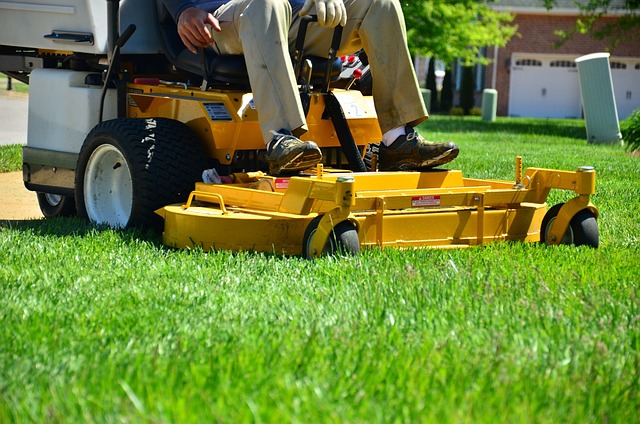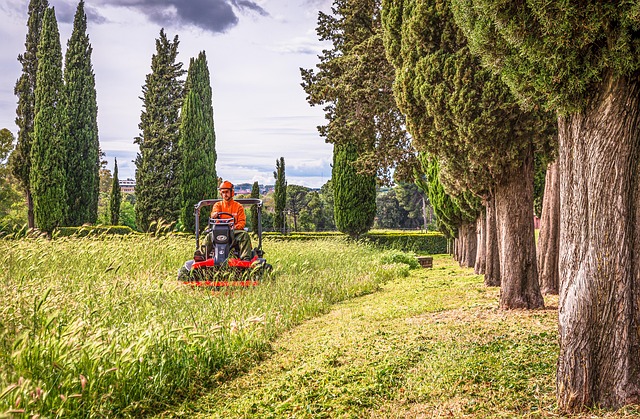Mulching and edging are essential practices in lawn care and landscaping. Mulch, either organic or inorganic, improves soil health, retains moisture, suppresses weeds, and regulates temperature, while effective edging defines lawn boundaries, prevents weed growth, maintains clean lines, and prolongs hardscape life. Together, these techniques enhance lawn aesthetics, reduce maintenance, and foster a vibrant, healthy outdoor space.
Transform your lawn into a picture of health and beauty with effective mulching and edging techniques. This comprehensive guide explores the essential practices for enhancing lawn care and landscaping. Discover the myriad benefits of mulching, from retaining moisture to suppressing weeds, and learn about various types suitable for different grass species. Edging, too, plays a crucial role in defining your lawn’s edges and preventing grass from encroaching on sidewalks and driveways. We’ll share best practices for integrating these techniques for optimal results.
- Understanding Mulching: Benefits and Types for Lawn Health
- Edging Techniques: Enhancing Your Lawn's Aesthetics and Functionality
- Integrating Mulching and Edging: Best Practices for Optimal Lawn Care
Understanding Mulching: Benefits and Types for Lawn Health

Mulching is an essential practice in lawn care and landscaping that offers numerous benefits for your grass and overall garden health. By applying a layer of organic or inorganic material on top of the soil, mulching helps retain moisture, suppress weeds, and regulate soil temperature. This natural process enhances the soil structure, allowing better air circulation and nutrient absorption, which is crucial for a lush, vibrant lawn.
There are various types of mulch available, each with unique advantages. Organic mulches, such as wood chips, straw, or compost, improve soil fertility over time. Inorganic options like rock, gravel, or rubber chips provide immediate weed suppression and don’t decompose, requiring less frequent replenishment. Choosing the right type depends on your lawn’s needs, aesthetic preferences, and maintenance goals. Effective mulching contributes to a healthy lawn ecosystem, making it a valuable practice for any dedicated gardener or landscape designer.
Edging Techniques: Enhancing Your Lawn's Aesthetics and Functionality

Edging is a crucial aspect of lawn care and landscaping, often overlooked but significantly contributes to your lawn’s overall appearance and health. There are several techniques to choose from, each enhancing different elements of your lawn. One common method is using edging tools like string trimmers or edgers to define the edge between your lawn and pathways, flower beds, or fences. This creates a clean, crisp line, instantly elevating the aesthetic appeal of your outdoor space.
Beyond aesthetics, edging serves functional purposes as well. It prevents grass from encroaching onto hardscapes, making maintenance easier and prolonging the lifespan of your pathways and patios. Additionally, it helps to control weeds by containing the growth of undesirable plants, reducing competition for nutrients with your desired lawn grasses. Effective edging combines both art and science, allowing you to create a balanced, harmonious landscape that not only looks good but also requires less overall upkeep.
Integrating Mulching and Edging: Best Practices for Optimal Lawn Care

Mulching and edging are essential practices in lawn care and landscaping that, when combined effectively, can transform your outdoor space. Mulching involves placing organic or inorganic material on top of the soil to retain moisture, suppress weeds, and enhance soil health over time. Edging, on the other hand, is the process of defining the boundary between your lawn and pathways, flower beds, or other landscaping features.
The best way to integrate these practices is by focusing on consistent application and regular maintenance. For mulching, aim for a layer between 2-4 inches deep, ensuring it’s evenly distributed across your lawn. This not only prevents weeds from receiving sunlight but also feeds the soil as the material decomposes. When edging, use sharp tools to create clean lines that highlight the contrast between your lawn and surrounding areas. Regularly trim these edges to maintain a polished look and prevent grass from encroaching onto pathways or other non-lawn surfaces.
Mulching and edging are essential components of effective lawn care and landscaping. By understanding the benefits of mulching, exploring various types, and mastering edging techniques, you can significantly enhance your lawn’s health, appearance, and functionality. Integrating these practices promotes a lush, well-maintained garden that becomes the envy of your neighborhood. So, whether you’re aiming for robust grass growth or a neat, professional look, incorporating mulching and edging into your routine is key to achieving and maintaining a beautiful outdoor space.














